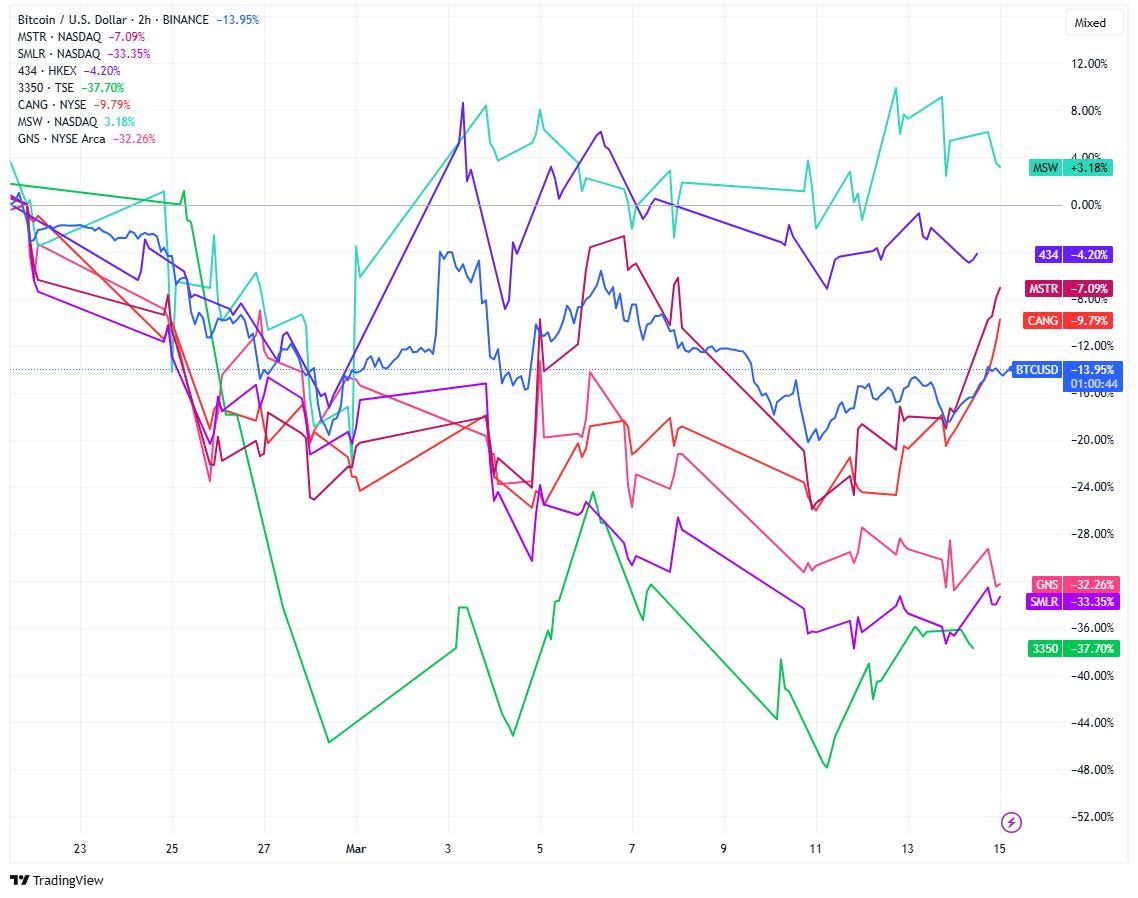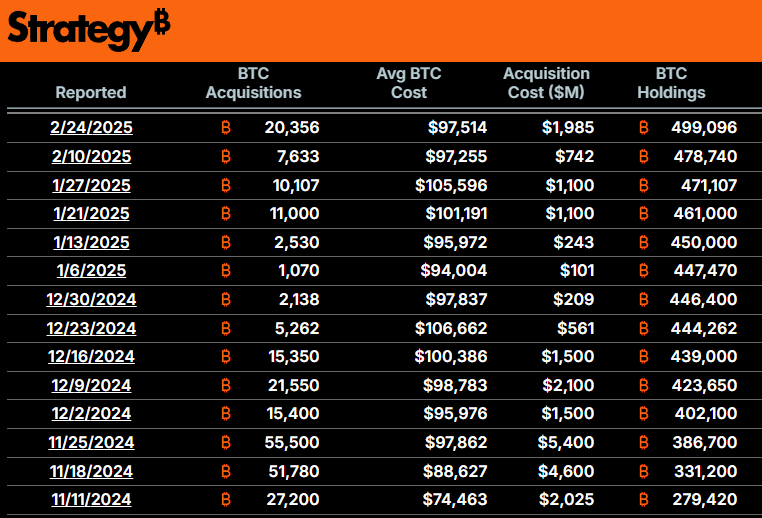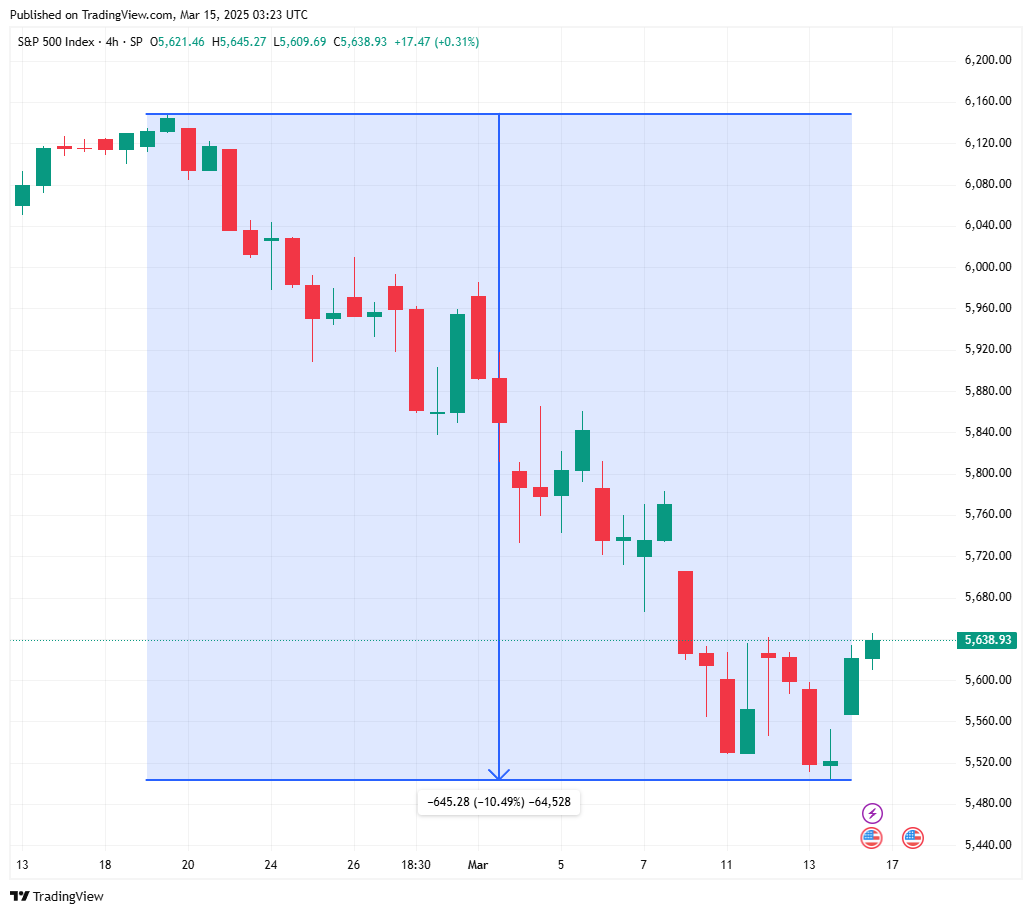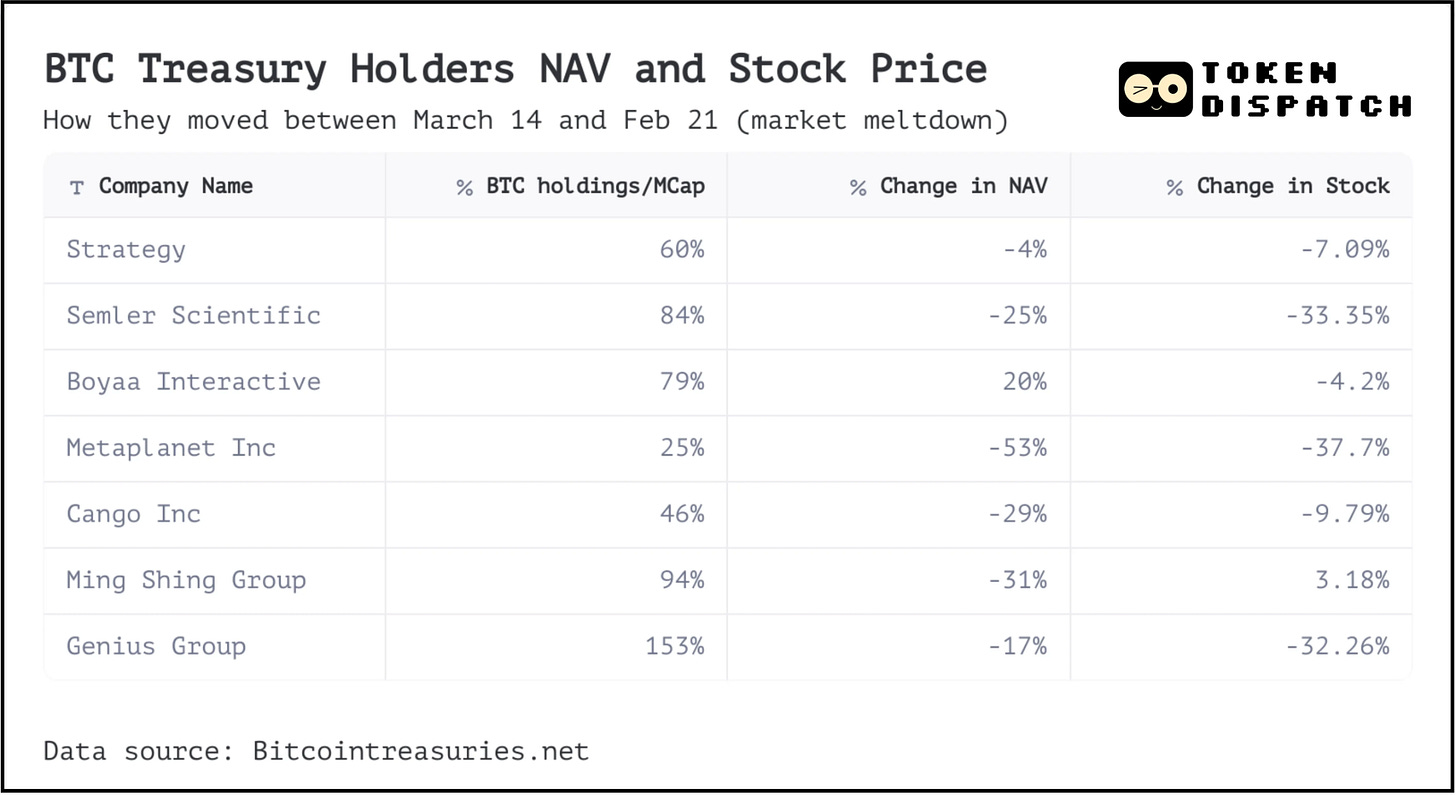Hello, y'all. Happy Saturday.
The markets and Bitcoin finally showed some correction yesterday. Yet, the wounds are deep and there’s time before we can say we are out of woods.
We want to share a perspective on how the markets moved over the past week and their impact on various crypto derivative products.
When markets tumble, the most leveraged bets feel it first. Right now, nothing looks more leveraged than public companies that have moved away from their primary businesses to bet their futures on Bitcoin treasuries.
As Bitcoin shed about a fifth of its market cap in the past two months, the stocks of companies mimicking Michael Saylor's Bitcoin strategy faced a much harsher slide — with some down over 35%.
March 2025's market meltdown hasn't been kind to anyone, but those following Saylor’s Bitcoin stacking strategy are getting a particularly brutal education in financial engineering during downturns.
In today's Wormhole, we dive into what's happening to these Bitcoin treasury stocks, why they're amplifying Bitcoin's losses, and whether this crash is a warning sign for investors seeking Bitcoin exposure through public equities.
Stake Smarter, Stay Liquid – with Marinade Finance!
Why choose between earning staking rewards and keeping your SOL accessible? With Marinade Finance, you get the best of both worlds.
Stake SOL in seconds & earn rewards effortlessly
Stay liquid with mSOL—use it across Solana DeFi
Non-custodial & secure—your assets remain yours
Boost Solana’s security while maximising your yield
No lockups, no waiting—just smarter staking designed for flexibility and growth. Whether you're a DeFi pro or just getting started, Marinade makes staking seamless and rewarding.
Stake your SOL today with Marinade Finance!
Bitcoin Drop Causes Market Panic
While Bitcoin tumbled about 14% in just the last three weeks, public companies that started holding Bitcoin treasuries have seen their stocks crater even harder.
The chart shows how when Bitcoin (the blue line) started dropping, these stocks followed suit and plummeted. The effect of the market meltdown and macro concerns hit them hard.
Get 17% discount on our annual plans and access our weekly premium features (HashedIn, Wormhole, Rabbit hole and Mempool) and subscribers only posts. Also, show us some love on Twitter and Telegram.
Even the largest corporate Bitcoin hodler - Strategy (earlier MicroStrategy) - wasn’t spared. It even forced Michael Saylor to bring almost a three-week pause in Bitcoin buys for the first time in four months.
Read: Has Saylor’s BTC Strategy Hit a Block? ⛔️
On Monday this week, when Bitcoin fell to $76,500 - 23% down from February 21, Strategy’s stock price had lost almost 30% of its market cap in the same time.
The Japanese firm Metaplanet, which transformed from running hotel business to a Bitcoin Treasury company, saw its stock lose 50% between February 21 and March 11.
Even companies such as Semler Scientific - which earlier focused heavily on providing healthcare technology - and Genius Group, an education technology provider, saw their stocks drop more than 30% during the three-week period.
Why the amplified drop? It's the double whammy effect.
First, these companies have explicitly tied their fortunes to Bitcoin. When Bitcoin drops, their primary asset loses value.
Second, market panic struck simultaneously. The S&P 500 dropped almost 10% from its February 19 peak by March 13, entering correction territory for the first time since October 2023. Investors fleeing to safety weren't interested in holding speculative Bitcoin proxy stocks.
The result? A sell-off that made Bitcoin's drop look mild in comparison.
That’s not all though. There’s more to why these stocks fall harder than Bitcoin itself.
NAV Premium Collapse Mechanics
During bull markets, Bitcoin treasury stocks trade at significant premiums to their Net Asset Value (NAV) — often 2-3x what their Bitcoin holdings are actually worth. Investors willingly pay this premium betting on:
Future Bitcoin appreciation
Management's ability to acquire more Bitcoin
The "scarcity" of Bitcoin exposure in public markets
Remember how in November 2024 Saylor managed to push the NAV premium to 3.311 for each MSTR share? It meant that investors valued Strategy’s stock 3.3 times the worth of its Bitcoin holdings.
Why? They believed that the Bitcoin price is likely to go up much more than the premium they were parting with.
What happens when sentiment shifts? Those premiums vanish overnight — or worse, turn into discounts.
Look at how the NAVs of these companies and their stock prices have changed since February 21.
See the pattern? In most cases, if the ratio of Bitcoin holdings to company’s overall market cap is higher, either its stock or the NAV premium performed worse during the crash.
Genius Group's position was particularly dire. With Bitcoin holdings valued at more than 150% of its market cap, investors are essentially saying the company's core business has negative value. Its tiny $23.37 million market cap makes it ultra-sensitive to Bitcoin swings.
Despite leading the pack with the highest number of Bitcoin held, Saylor’s Strategy got away with relatively marginal losses.
What does this say about the financial model?
The Bitcoin treasury strategy relies on a continuous virtuous cycle.
Buy Bitcoin with available cash
Watch Bitcoin (hopefully) appreciate
Use your appreciated Bitcoin as collateral to borrow more
Issue shares at premium valuations to buy even more Bitcoin
Repeat steps 2-4 indefinitely
It's brilliant when markets cooperate. The trouble starts when they don't.
The March meltdown exposes the fragility of this model. When Bitcoin drops and market sentiment sours simultaneously, the entire financial engineering structure craters:
Premium valuations disappear, making share issuance dilutive
Collateral value decreases, reducing borrowing capacity
Investor confidence falters, creating selling pressure
Smaller float companies face liquidity crunches
Strategy has weathered these cycles before. Its sophisticated approach includes carefully timed debt and equity toggles, hedging strategies, and strategic timing of acquisitions.
But for newcomers? It's a trial by fire.
This is the hidden risk of the Saylor playbook: it works until it doesn't, and when it breaks, it hurts the smaller players the most.
The Bitcoin Multiplier Effect
Bitcoin treasury stocks behave as leveraged Bitcoin positions, with volatility multiplied in both directions.
During the 2021 bull run, MicroStrategy shares rose 1,300% while Bitcoin gained 300% - a 4.3x amplification factor. Now we're seeing the same multiplier work in reverse.
Bitcoin down 14%
Treasury stocks down up to 37% (average: 18%)
This multiplier effect means these stocks aren't merely Bitcoin proxies - they're Bitcoin on steroids. Great when markets are green, devastating when they turn red.
Token Dispatch View 🔍
Don’t misunderstand Bitcoin treasury bloodbath to be a death note to Saylor's strategy. It proves that execution, timing, and scale matter enormously for such highly-leveraged derivatives.
Strategy started accumulating Bitcoin at $11,000 in 2020, giving it massive cushion against downturns. New entrants buying Bitcoin above $80,000 in early 2024 and 2025 simply don't have that luxury. This timing gap is now being reflected in their stock performances.
It’s a classic case of survival of the fittest. Those with robust balance sheets, substantial market caps, and sophisticated capital allocation strategies can weather the storm. Smaller players who jumped in near the recent peak are learning hard lessons about the dangers of financial engineering when markets turn south.
The March meltdown exposes another critical truth: the NAV premium phenomenon is cyclical and sentiment-driven. Companies that based their entire business model on continuously issuing shares at premium valuations to acquire more Bitcoin are now facing a reality check. When Bitcoin drops 14%, their stocks can drop 30% or more as both the asset value and the premium collapse simultaneously.
For investors, here are some key takeaways:
Bitcoin treasury stocks are not Bitcoin substitutes - they're amplified bets with significantly higher volatility in both directions. Higher the reward, bigger the risk - isn’t it?
Size and diversification matter - companies with larger market cap or those with substantial non-Bitcoin business value have demonstrated greater resilience during this correction
Premium compression is predictable - what trades at 3x NAV in euphoric markets might trade at 1x or below during corrections, creating both risks and potential opportunities
For established players like Strategy with significant cushion and sophisticated treasury management, this correction is likely just another bump in their long-term accumulation strategy.
For smaller newcomers who entered near the top, difficult decisions await. Some may need to add alternative business lines to their organitsation, while others might face existential questions about continuing their Bitcoin strategy altogether.
The market is ruthlessly separating the Saylor apprentices from the master. Not everyone who copies a strategy understands its nuances or has the resources to execute it properly. In markets like these, those distinctions become painfully clear.
Token Dispatch is a daily crypto newsletter handpicked and crafted with love by human bots. You can find all about us here 🙌
If you want to reach out to 200,000+ subscriber community of the Token Dispatch, you can explore the partnership opportunities with us.
Disclaimer: This newsletter contains sponsored content and affiliate links. All sponsored content is clearly marked. Opinions expressed by sponsors or in sponsored content are their own and do not necessarily reflect the views of this newsletter or its authors. We may receive compensation from featured products/services. Content is for informational purposes only, not financial advice. Trading crypto involves substantial risk - your capital is at risk. Do your own research.














